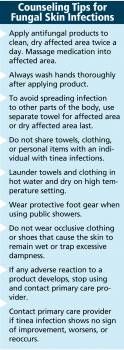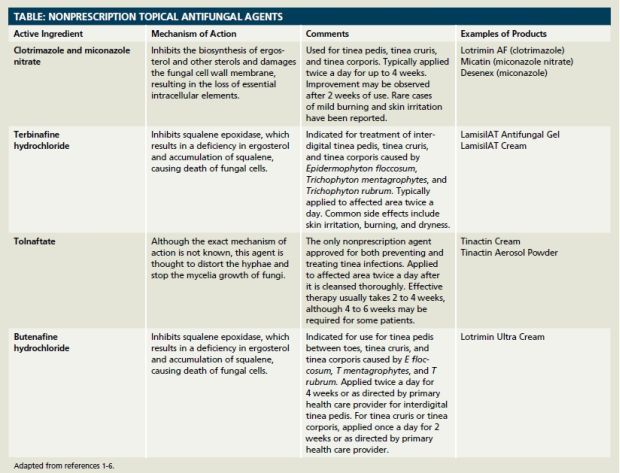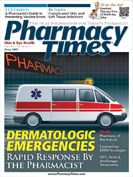Publication
Article
Pharmacy Times
Combating Fungal Skin Infections
Author(s):
Pharmacists can recommend products to relieve the itching, cracking and burning of fungal skin infections.
Pharmacists can recommend products to relieve the itching, cracking and burning of fungal skin infections.
Dermatomycoses, also referred to as fungal skin infections, are commonly occurring cutaneous disorders.1,2 These types of infections are typically superficial and can involve the hair, nails, and skin.1,2
The most prevalent fungal skin infection in humans is tinea pedis, commonly known as athlete’s foot.1 Onychomycosis, or tinea unguium, which affects the nails, may occur in conjunction with tinea pedis.1,2 The other 3 most commonly occurring fungal skin infections are tinea corporis (ringworm of the body) and tinea capitis (ringworm of the scalp), which are most prevalent among prepubescent patients, and tinea cruris (jock itch), which is most prevalent among adult men.1,2
The symptoms of these infections vary in severity. Self-treatment of onychomycosis with topical nonprescription antifungals is not approved by the FDA; instead, prescription systemic agents or surgical removal of the affected area is recommended as treatment for this typeof infection.1,2 Tinea capitis also cannot be managed with topical nonprescription antifungals.1 Some fungal skin infections are amenable to self-treatment with topical nonprescription antifungals, however.
OTC Topical Antifungals
The goals of treating antifungal skin infections are to provide the patient with symptomatic relief, successfully eliminate infection, and prevent recurring infections.1 There are several products available to effectively self-treat tinea pedis, tinea corporis, and tinea cruris.1 These products relieve the itching, burning, skin cracking, and scaling that are often caused by fungal skin infections.

OTC topical antifungal agents, including butenafine hydrochloride, clotrimazole, miconazole nitrate, terbinafine hydrochloride, and tolnaftate, are considered safe and effective for use in the treatment of mild-to-moderate fungal skin infections.1 These agents are available as ointments, solutions, lotions, creams, powders, and aerosols. There are also various topical nonprescription products available to decrease nail discoloration and smooth out thick or rough nails during prescription therapy for onychomycosis.1

Patients should discuss the use of fungal nail treatment products with their primary health care provider. According to the Handbook of Nonprescription Drugs, creams and solutions are considered the most effective and efficient dosage forms for delivering medication to the epidermis; sprays and powders are considered less effective because they are often not rubbed into the skin.1 However, sprays and powders are considered useful in conjunction with creams and solutions or as preventive agents for new or recurring infections.1
Counseling Points
Prior to recommending any antifungal medication, pharmacists should evaluate the patient’s medical history and screen for possible contraindications. Patients with diabetes, circulatory problems, or those who are immunocompromised should be referred to their primary health care provider prior to using any of these products.1
During counseling, patients should be advised about the proper use of these products and be made aware of the recommended duration of therapy, which is typically 2 to 4 weeks, although it can be longer for some patients. Patients should be reminded of the importance of adhering to therapy in eradicating tinea infections. Patients should also be advised of nonpharmacologic measures that can help prevent or decrease the incidence of recurring infections and transmission of infection to others. Patients who experience recurring infections should be referred to their primary health care provider because they may be an indication of undiagnosed diabetes, immune system disorder, or another medical problem.1
Ms. Terrie is a clinical pharmacy writer based in Haymarket, Virginia.
References
1. Newton G, Popovich N. Fungal skin infections. In: Krinsky D, Berardi R, Ferreri S, et al, eds. Handbook of Nonprescription Drugs. 17th ed. Washington, DC: American Pharmacists Association; 2012.
2. Dermatophytoses. Merck Manual for Healthcare Professionals Online Edition. www.merckmanuals.com/professional/dermatologic_disorders/fungal_skin_infections/dermatophytoses.html. Accessed March 30, 2012.
3. Lotrimin product information. MSD Consumer Care, Inc website. www.lotrimin.com/products/index.html. Accessed March 30, 2012.
4. Tinactin product information. MSD Consumer Care, Inc website. Accessed March 30, 2012.
5. Lamasil AT. Novartis Consumer Health Inc website. www.lamisilat.com/products/lamisil-cream-for-jock-itch/drug-facts.shtml. Accessed March 30, 2012.
6. Micatin Product Information. WellSpring Pharmaceutical Corporation website. www.micatin.com/product-info.html. Accessed March 29, 2012.







